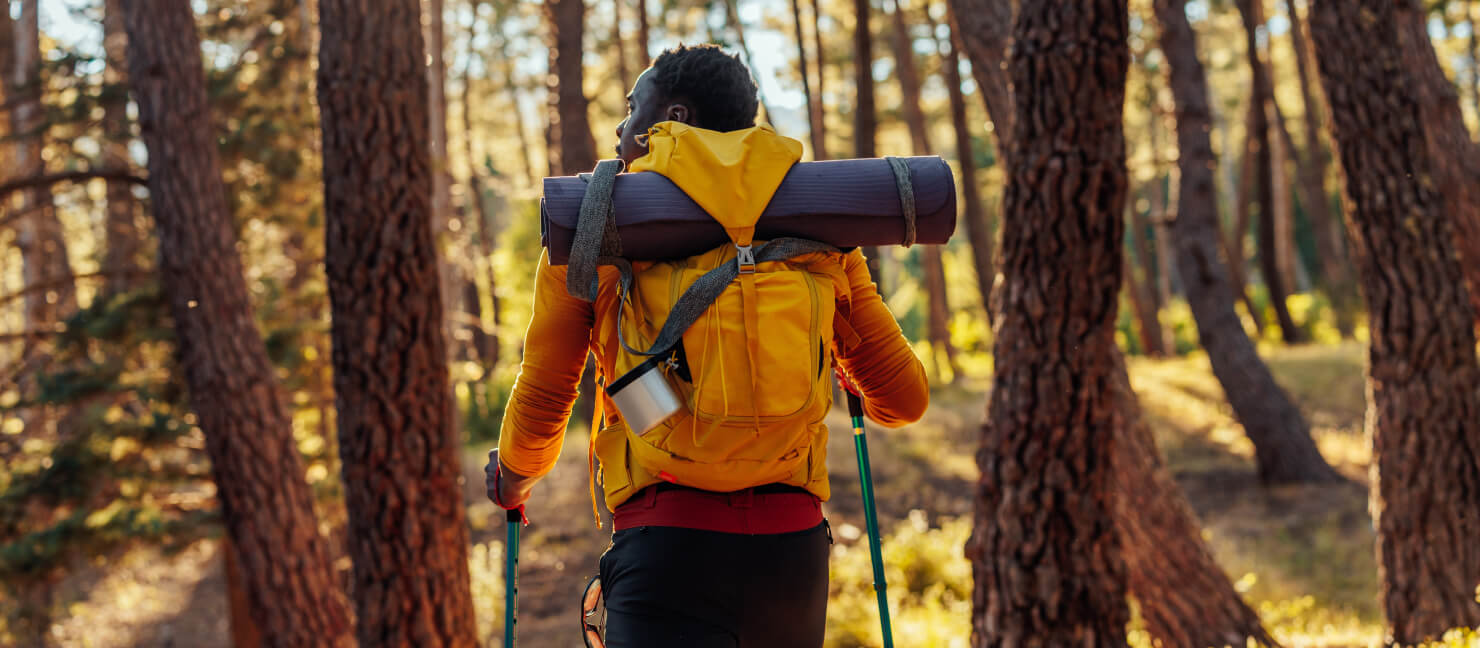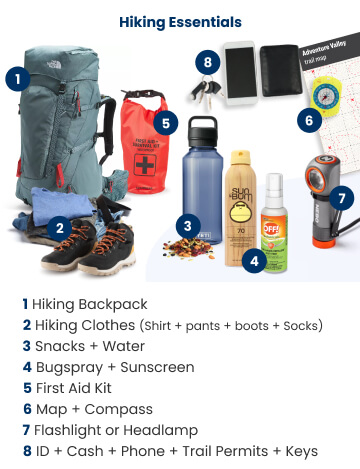Hiking Essentials + Supplies You Should Bring on a Hike

Ready to conquer those hiking trails? Whether you're exploring a nearby path or delving deep into the heart of a remote state park, having the appropriate hiking supplies is crucial. In this guide, you’ll learn all about how to gear up with the right hiking essentials so you can embrace the spirit of the outdoors!
Key Takeaways
- Learn what to bring on a hike using our general hiking essentials checklist so you have a good idea of what to pack.
- Find out what you need for shorter day hikes (2 hours or less) and what to bring on a longer hike (2+ hours).
- Check out our list of optional hiking supplies that assist you in preparing for unforeseen weather, blisters, and other challenges on the trail.
- Understand what not to take on a hike to avoid weighing down your outdoor backpack with useless gear.
- View the essential hiking supplies you need at a glance. Save our infographic to your phone before you go shopping!
Hiking Essentials Checklist: What to Bring
We compiled this hiking essentials checklist so you have a good idea of what to pack — especially if it’s your first time venturing out on a trail. Always research your trail beforehand, bring plenty of water, and choose your hiking gear wisely.
Hiking Outfit + Essentials
-
Snacks
-
Water + hydration pack
-
Map + compass
Hiking Safety + Sanitary Gear
-
ID, cash, trail permits, keys
-
Toilet paper
Hiking Extras
-
Lighter + matches
Hiking Luxuries
-
Bandana
-
Apps like AllTrails
-
Hand warmers
-
Hand sanitizer
-
Chapstick
Prepping for an epic hiking adventure? Download our hiking essentials checklist to streamline your search for hiking supplies — both online and in-store.

What to Pack for a Day Hike
Nothing beats a short day hike to enjoy the fresh air. Beginners may feel tempted to shove as much stuff into their pack — you know, just in case! But keep in mind that you’ll be stuck hauling all that weight. Just pack the essentials. Dress in layers, and keep the season in mind.
Hiking Basics
-
Hiking Backpack: A hiking backpack is essential to carry all your gear. For short hikes, a backpack with a capacity of 15-30 liters should suffice.
-
Hiking Clothes: Choose breathable, moisture-wicking hiking clothes. This includes boots, pants, shirts, socks, and more.
-
Trekking Poles: Trekking poles increase your stability and speed as well as offload weight from your pack. Opt for trekking poles on challenging hikes.
-
Navigation Tools: Carry printed maps, a compass, or a GPS device. Ensure you know your trail, exit points, and more.
-
Raingear: Make sure to bring a rain jacket for unexpected downpours. Even on mild days, hypothermia can occur when you're wet.
-
Hiking Accessories: Bring sunglasses, a hat, gloves, and other hiking essentials. These items are perfect for keeping you comfortable during your hiking experience.
-
Personal Items: Don't forget to carry essential personal items like ID, cash, trail permits, and keys. Prior to your hike, research the trail to determine the necessary permits.
-
Flashlight/Headlamp: Carry a flashlight or headlamp — especially if the sun begins to set while you hike. These are invaluable for reading your map and illuminating your path.

Hiking Necessities + Safety
-
Water + Snacks: Snacks help you refuel before, during, or after the hike. Pack at least 1 liter of water for every 2-5 miles. Consider using a hydration pack for added convenience or for longer hikes.
-
Safety Whistle: Blow your safety whistle three times for help. A whistle can give you peace of mind when you’re dealing with the unexpected (like an injury).
-
First Aid Kit: Ensure you pack a first aid kit for minor scrapes and bruises. You wouldn't want a cut to disrupt your entire hike — even on a short one.
-
Bug Spray + Sunscreen: Mosquitoes can be quite active in warmer weather. Use bug spray to prevent nasty bug bites and sunscreen to protect your skin from burning.
-
Bear Spray: When venturing deep into the woods or bear territory, have bear spray on hand. Know how to use it when necessary before you set off on your hike.
-
Toilet Paper: If you're hiking in the backcountry, have toilet paper, hand sanitizer, or wipes. Don't forget to pack baggies for the toilet paper.
-
Knife or Multi-Tool: If you're heading deep into the woods, carry a knife or multi-tool. A multi-tool is handy for quick fixes.
-
Two-Way Radio: Two-way radios maintain communication with other hikers in your group. This can be particularly valuable when your group separates.

What to Pack for a Day Hike (2 Hours or More)
Longer hikes usually need a pack similar to the shorter ones. However, you’ll want to consider potentially upgrading a few pieces for the longer trek (like upgrading your water bottle to a hydration pack for example). Among the essentials, here are a few other things to consider bringing with you:
-
Binoculars: Consider bringing binoculars — especially if you enjoy bird-watching and spotting hawks during your hike. They also provide a closer and more personal view of nature.
-
Repair Kit: Carry repair tape for patching holes in fabrics like jackets, tents, or tarps. You can find repair tape that’s weatherproof or resistant and easy to apply in a pinch!
-
Camera: Action cameras can capture any wildlife and beautiful sights you stumble across on your hike.
Expert Tip:
Consider buying travel-sized bottles for sunscreen, hand sanitizer, tissues, and other essentials to maximize space in your pack. Organizing your belongings in ziplock bags can also help keep things tidy.
Other Hiking Supplies
Consider adding these items to your pack if space allows. From a bandana to keep your neck cool to moleskin for blisters, check out our list of optional hiking items:
-
Rain pack cover: An outdoor backpack cover is like a shell for your backpack. It protects your pack from getting wet.
-
Moleskin: Moleskin blister dressings are great for patching up blisters anywhere on your feet.
-
Space Blanket: Emergency blankets can regulate your body temperature and keep you warm. It can also double as an emergency shelter.
-
Fire Starter: If you intend to build a fire at any point, bring fire starter supplies. A lighter and matches are a start, but windy conditions can pose a real challenge when you try to ignite them.
Depending on many factors (like the weather, your destination, the elevation/terrain, or the time of year), you’ll want to also consider the following items:
-
Rope
-
Bandana
-
Apps like AllTrails
-
Hand Warmers
-
Hand Sanitizer
-
Chapstick

What Not to Take on a Hike
Leave certain items at home to avoid unnecessary weight. Check out our list of items you can skip while hiking:
-
Jewelry
-
Valuables
-
Heavy books
-
Unneeded camera equipment
-
Hiking chair
-
Laptop and other technology or equipment
-
Portable coffee maker
-
Cooler
-
Sleeping bag + sleeping pad + camping pillow
-
Tent (unless you plan to backpack)
-
Hammock
-
Cooking equipment
-
Games
-
Umbrella
Last-Minute or Beginner Hiking Essentials
Need to pack on short notice? Hiking locally or closer to major cities won’t usually require as much gear. For hikers looking to get started (or get in some practice before a longer hike), here are the 10 items we consider non-negotiable hiking essentials:
-
Hiking backpack
-
Hiking clothes (shirt, pants, boots, & socks)
-
Snacks
-
Water
-
Bugspray
-
Sunscreen
-
First aid kit
-
Map + compass
-
Flashlight or headlamp
-
ID, cash, trail permits, and keys

Have Fun Out There!
Ready to set off on your hike? To get the most out of your hiking experience, you’ll need to prepare with the right hiking gear. At Academy, we carry everything you need for two-hour day hikes or 12-hour hiking adventures. Shop our selection of trekking poles, hiking clothes, and much more!


